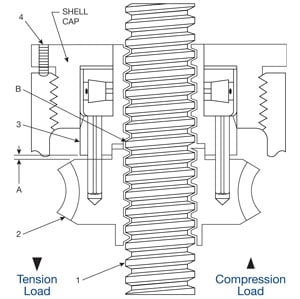Anti-backlash Screw Jacks
Screw Jacks
1/4-to-250-ton capacity. Anti-backlash actuators reduce vertical backlash resulting in smooth, precise operation and minimal wear.
Features and Benefits
FEATURES AND BENEFITS
Superior Design
Duff Norton's anti-backlash design features a separate anti-backlash nut capable of reducing actuator backlash to less than 1 thousandths.
Reliability
Anti-backlash actuators can lock and reliably hold a load, thereby eliminating the need for brake motors required for some applications.
Minimum Backlash
Duff-Norton developed the anti-backlash actuators to reduce screw-to-nut backlash to an absolute minimum.
Adjust With No Disassembly
As wear occurs, the actuator can be easily adjusted, without any disassembly, to return the backlash to its’ original minimum value.
Numeric Ratios
Available with standard, optional, & numeric ratios.
Stainless Steel Options
Available in stainless steel for most capacities.
Options
| Capacity Tons | 1/8 | 1/4 | 1/2 | 1 | 2 | 5 | 10 |
|---|---|---|---|---|---|---|---|
| Model Number | E250 | E500 | E1000 | E2000 | E4000 | E10000 | E20000 |
| Maximum Speed C-face Driven (in/min) | — | — | — | — | 72 | 108 | 108 |
| Maximum Speed Reducer Driven (in/min) | — | — | — | — | 14.1 | 21.9 | 21.9 |
| Lifting Screw - Diameter (in) | 1/2 | 1/2 | 5/8 | 3/4 | 1 | 1-1/2 | 2 |
| Lifting Screw - Pitch | 0.25 | 0.25 | 0.125 | 0.2 | 0.25 | 0.375 | 0.5 |
| Lifting Screw - Type | ACME | ACME | ACME | ACME | ACME | ACME | ACME |
| Worm Gear Rations | 5:1 | 5:1 | 5:1 | 5:1 | 6:1 | 6:1 | 8:1 |
| Turns of Worm for 1 inch Stroke | 20 | 20 | 40 | 25 | 24 | 16 | 16 |
| Worm Torque at No Load (in-lb) | 2 | 2 | 2 | 5 | 5 | 10 | 20 |
| Maximum Horsepower per Actuator | 1/3 | 1/3 | 1/3 | 1/2 | 2 | 4 | 5 |
| Worm Torque at Full Load* (in-lb) | 13 | 13 | 21 | 55 | 120 | 450 | 750 |
| Effeciency Rating (%) | 30.6 | 30.6 | 18.9 | 23.1 | 22.1 | 22.1 | 26.5 |
| Key Torque (in-lb) | 40 | 40 | 70 | 175 | 460 | 1750 | 4700 |
| Maximum Worm Speed at Full Load (Rpm) | 1616 | 1616 | 1000 | 573 | 1051 | 560 | 420 |
| Maximum Load at Full Horsepower ad 1750 Rpm (lb) | 455 | 455 | 527 | 520 | 2332 | 3047 | 4386 |
| Weight with 3 inch Stroke (lb) | 2 | 2 | 2 | 5 | 17 | 34 | 52 |
| Weight per Additional 1 inch Stroke (lb) | 0.1 | 0.1 | 0.1 | 0.3 | 0.3 | 0.9 | 1.4 |
How anti-backlash worksWhen the screw (1) is under a compression load, the bottom of its thread surfaces are supported by the top thread surfaces of the worm gear (2). The anti-backlash nut (3), being pinned to the worm gear and floating on these pins and being adjusted downward by the shell cap, forces its bottom thread surfaces against the upper thread surfaces of the lifting screw at point (B). Thus, backlash between the worm gear threads and the lifting screw threads is reduced to a regulated minimum. When wear occurs in the worm gear threads and the Anti-backlash nut thread, the load carrying thickness of the worm gear thread will be reduced. This wear will create a gap at point (B) and provide backlash equal to the wear on the threads. |
|
|
|
Under a compression load, the lifting screw will no longer be in contact with the lower thread surface of the anti-backlash nut. Under this condition, backlash will be present when a tension load is applied. The anti-backlash feature can be maintained simply by adjusting the shell cap until the desired amount of backlash reduction is achieved. This will reduce the separation (A) between the anti-backlash nut and the worm gear and will reduce the backlash between the worm gear threads and the lifting screw to the desired minimum value. This will reduce the separation (A) between the anti-backlash nut and the worm gear and will reduce the backlash between the worm gear threads and the lifting screw to the desired minimum value. To avoid binding and excessive wear, do not adjust lifting screw backlash to less than .0005". |
Why Anti-Backlash Control is ImportantEven the best manufacturing processes produce clearances between a screw and a mating nut. In applications where loads may be in either direction, backlash can result from these clearances creating unacceptable movement in the controlled mechanism as loads change. These applications are common in the paper, plastic, film, sheet metal forming processes, satellite, or other load-reversing applications. Such applications may be subjected to extreme vibrations. These vibrations can produce constant movement between the screw and lifting nut which can hammer the threads and cause premature wear. To reduce this screw-to-nut backlash to an absolute minimum, Duff-Norton developed Anti-Backlash actuators. The design allows the backlash to be adjusted to a minimum value practical. As wear occurs, the actuator can be easily adjusted, without any disassembly, to return the backlash to its’ original minimum value. NOTE: Use anti-backlash as a safety device or to provide wear indication for critical applications. Keyed antibacklash models may require (A) key adaptor, which projects below jack base. |
|



 North America - EN
North America - EN





